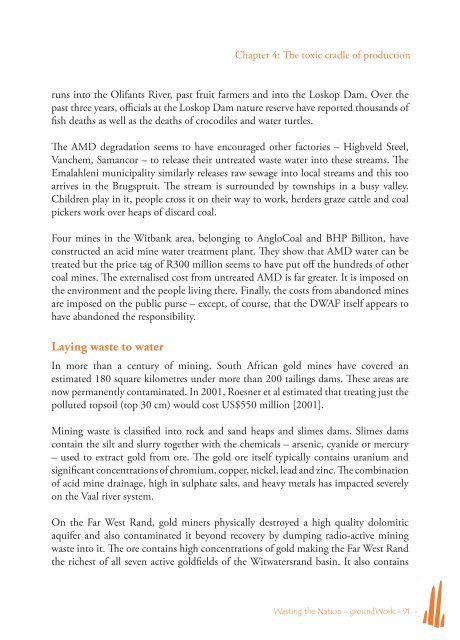Wasting the Nation.indd - Groundwork
Wasting the Nation.indd - Groundwork
Wasting the Nation.indd - Groundwork
You also want an ePaper? Increase the reach of your titles
YUMPU automatically turns print PDFs into web optimized ePapers that Google loves.
Chapter 4: The toxic cradle of productionruns into <strong>the</strong> Olifants River, past fruit farmers and into <strong>the</strong> Loskop Dam. Over <strong>the</strong>past three years, officials at <strong>the</strong> Loskop Dam nature reserve have reported thousands offish deaths as well as <strong>the</strong> deaths of crocodiles and water turtles.The AMD degradation seems to have encouraged o<strong>the</strong>r factories – Highveld Steel,Vanchem, Samancor – to release <strong>the</strong>ir untreated waste water into <strong>the</strong>se streams. TheEmalahleni municipality similarly releases raw sewage into local streams and this tooarrives in <strong>the</strong> Brugspruit. The stream is surrounded by townships in a busy valley.Children play in it, people cross it on <strong>the</strong>ir way to work, herders graze cattle and coalpickers work over heaps of discard coal.Four mines in <strong>the</strong> Witbank area, belonging to AngloCoal and BHP Billiton, haveconstructed an acid mine water treatment plant. They show that AMD water can betreated but <strong>the</strong> price tag of R300 million seems to have put off <strong>the</strong> hundreds of o<strong>the</strong>rcoal mines. The externalised cost from untreated AMD is far greater. It is imposed on<strong>the</strong> environment and <strong>the</strong> people living <strong>the</strong>re. Finally, <strong>the</strong> costs from abandoned minesare imposed on <strong>the</strong> public purse – except, of course, that <strong>the</strong> DWAF itself appears tohave abandoned <strong>the</strong> responsibility.Laying waste to waterIn more than a century of mining, South African gold mines have covered anestimated 180 square kilometres under more than 200 tailings dams. These areas arenow permanently contaminated. In 2001, Roesner et al estimated that treating just <strong>the</strong>polluted topsoil (top 30 cm) would cost US$550 million [2001].Mining waste is classified into rock and sand heaps and slimes dams. Slimes damscontain <strong>the</strong> silt and slurry toge<strong>the</strong>r with <strong>the</strong> chemicals – arsenic, cyanide or mercury– used to extract gold from ore. The gold ore itself typically contains uranium andsignificant concentrations of chromium, copper, nickel, lead and zinc. The combinationof acid mine drainage, high in sulphate salts, and heavy metals has impacted severelyon <strong>the</strong> Vaal river system.On <strong>the</strong> Far West Rand, gold miners physically destroyed a high quality dolomiticaquifer and also contaminated it beyond recovery by dumping radio-active miningwaste into it. The ore contains high concentrations of gold making <strong>the</strong> Far West Rand<strong>the</strong> richest of all seven active goldfields of <strong>the</strong> Witwatersrand basin. It also contains<strong>Wasting</strong> <strong>the</strong> <strong>Nation</strong> - groundWork - 91 -
















